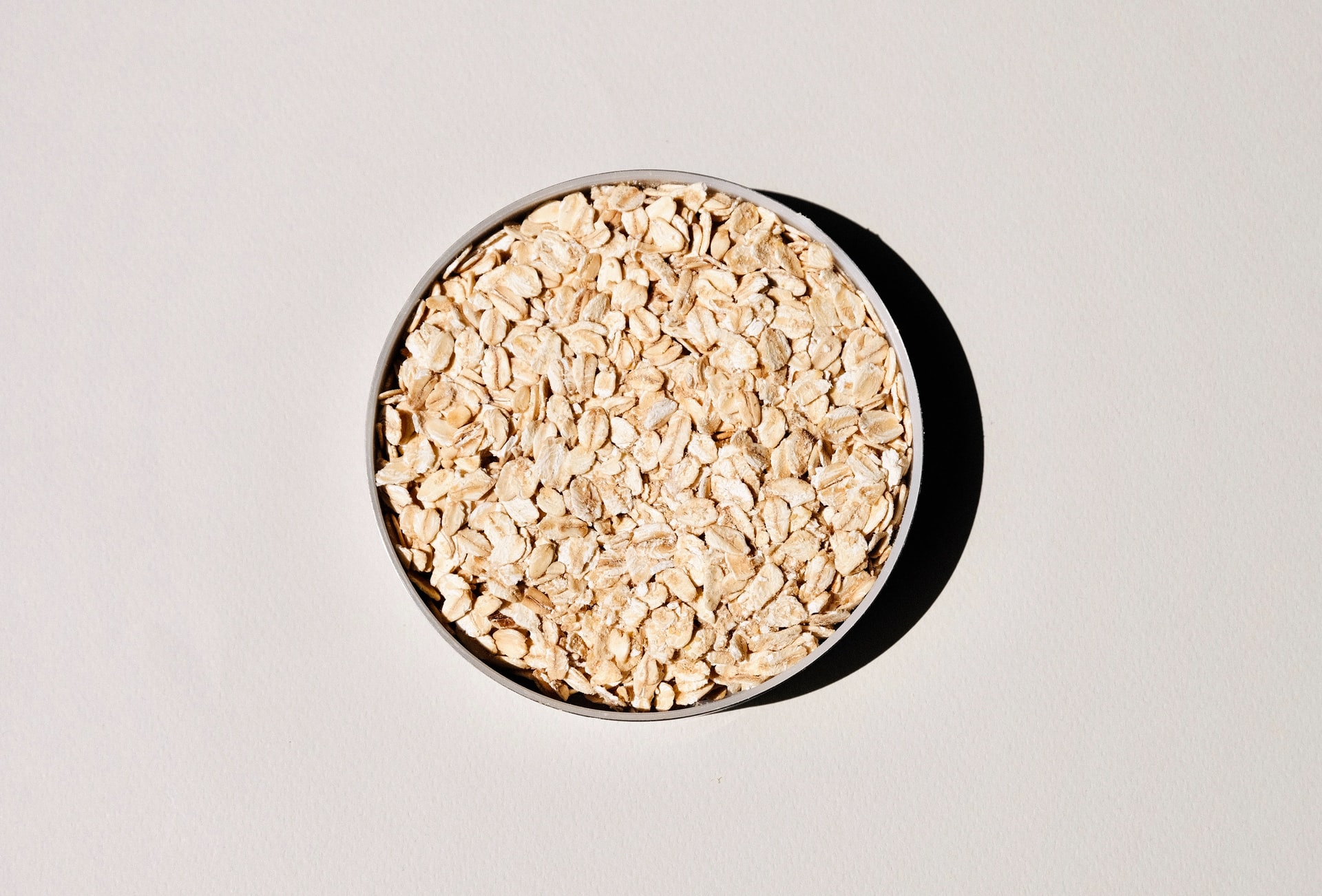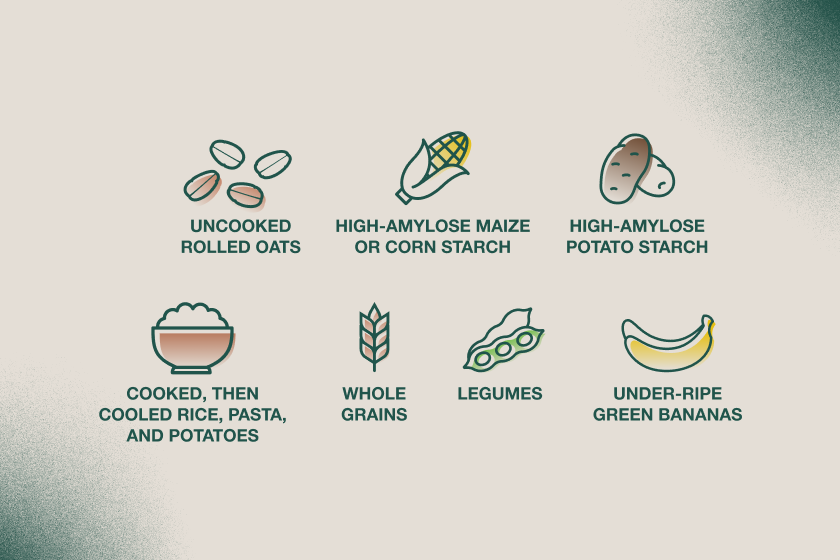When it comes to how much resistant starch you should get each day, it’s probably more than you think. And it’s almost certainly more than you’re currently getting.
The truth is, there’s no formal daily recommended amount.
Some sources hypothesize that our ancestors historically consumed around 30-50 grams of resistant starch per day, in the form of foods such as savanna tubers, roots, raw potatoes, green bananas, uncooked rolled oats, legumes, beans, and more. [1]
Other studies suggest 15 grams represents adequate consumption. [2] Still, other studies show health benefits observed with a daily intake of at least 20 grams. And an intake as high as 45 grams per day doesn’t cause any adverse effects. [3, 4]
This much is clear: Our current RS status quo is a big status no-no. The average American only gets about 2.8-7.9 grams of RS per day. [5]
Here’s why that’s not ideal, plus some things you can do to fix it.
What is Resistant Starch and Why Should I Add it to My Diet?

Resistant starch is a unique carbohydrate and specific kind of prebiotic fiber found in starchy foods such as raw potatoes, green bananas, whole grains like oats, legumes, and more.
It’s called “resistant starch” because it “resists” early-phase digestion, and travels mostly intact to the gut where it’s then used as food by beneficial bacteria in your microbiome.
As a prebiotic fiber, resistant starch focuses less on nourishing the body immediately in the form of quick-hit glucose energy, and more on nourishing your health long-term through your gut.
By feeding the probiotics (living microbes) in your gut with prebiotics (plant fibers that probiotics use as fuel and need in order to thrive), this effectively unlocks all sorts of good-for-you postbiotic reactions (like the release of short-chain fatty acids and other healthy byproducts that occur during fermentation).
An easy formula to remember is: Prebiotics + Probiotics = Postbiotics.
The Health Benefits of Resistant Starch

The health benefits of resistant starch are both multifaceted and unilaterally huge. From better blood sugar to improved weight management, resistant starch is truly one of the most underrated, untapped superfoods for achieving better gut health — and by extension better overall health.
When the good bacteria in your gut feast on resistant starch, this fermentation process unleashes a range of healthy metabolites, like the short-chain fatty acids (SCFAs) we’ve already mentioned, as well as B vitamins, amino acids, and more.
Butyrate, in particular, is perhaps most commonly associated with RS. It may be a short-chain fatty acid, but it’s got some pretty long-term health benefits!
Studies show that butyrate can reduce inflammation, relieve gastrointestinal conditions, increase insulin sensitivity, enhance sleep, and even improve brain functionality through the gut-brain axis. [6]
Does it Really Matter How Much Resistant Starch Per Day I Get?

If gut health and general well-being are your goals, then yes — it absolutely matters how much resistant starch you get per day.
Again, the precise amount you should strive for is still a bit undetermined. We’re learning more and more about this powerful plant-based superfood every day!
But when you look at the broader landscape of overall fiber intake, it’s easy to see where getting more RS fits in.
The recommended daily intake of dietary fiber is about 25-38 grams per day. The vast majority of Americans don’t get anywhere close to this amount. In fact, only about 5% of them do! [7]
Getting more RS in your diet is a fantastic way to bridge the fiber gap.
Pretty much all plant fibers are beneficial for different reasons. Resistant starch is great because of its prebiotic effect and its release of SCFAs like butyrate. The key to a healthy gut (and overall health in general) is microbial diversity in your gut. [8]
So, getting a wide variety of whole foods and plant-based fibers like RS is crucial.
Can Too Much RS Cause Problems?
As with most things in life, the general rule is “everything in moderation.” With resistant starch, this logic of course applies. But, to be honest, you’d have to consume A LOT of RS in order to swing the pendulum into “overdoing it” territory.
That’s because of a couple of factors:
- You’re probably starting out on the backfoot in terms of how much resistant starch you need versus how much you’re actually getting. AKA, you’ve got some ground to cover!
- RS is also low FODMAP, which means it’s easier on your gut than certain other prebiotic fibers. Fibers like inulin, for instance, can cause gastrointestinal issues for some people (especially those suffering with IBS). But RS can be tolerated more easily.
That said, fiber is fiber. And because we, as a society, are massively and collectively undernourished from a fiber intake perspective, it’s only natural that increasing the amount of fiber in your diet can sometimes cause some gastrointestinal growing pains. (That’s why we recommended starting out with half a serving of Supergut when first introducing RS into your diet.)
But just know: even if your gut feels a little topsy-turvy when consuming more RS, this is just a sign that your gut is beginning to heal!
So, How Much RS Per Day Should I Aim For?

How much resistant starch you should eat per day varies. Again, some studies mentioned earlier suggest that 15-20 grams of RS can lead to health benefits. Others show that as much as 45 grams is still okay.
In our own gold-standard clinical trial, we saw over the course of 12 weeks that a dose of 20 grams of Supergut’s patented prebiotic resistant starch blend led to significant improvements across a variety of wellness indicators, including energy, sleep, digestive health, and more.
We also saw some pretty major improvements with metabolic health, including better blood sugar control (with an average A1C reduction of 0.7%) and improved weight management (with an average 3lbs lost).
Our Recommendation:
Opt for a diet high in a variety of whole foods and fiber. A healthy gut is one with a lot of microbial diversity. So, feeding your gut a wide range of plant-based fibers is an optimal way of encouraging more growth of beneficial bacteria in your microbiome.
Resistant starch, specifically, is not only a great way to get more fiber. It’s also a unique supernutrient with some very specific health benefits. The ample production of SCFAs, like butyrate, that are unleashed by eating RS leads to all sorts of health benefits, including better blood sugar, improved sleep, enhanced energy, and more.
So, by all means, make sure to incorporate a wide range of fiber. But be sure that a decent chunk — about 20 grams — is resistant starch.
How to Incorporate Resistant Starch into Your Diet

There are lots of different sources of resistant starch to choose from. Foods that are high in RS include:
- Any starch that has been cooked, then cooled (such as rice, potatoes, and pastas)
- Whole grains such as barley and steel cut oats
- Plantains and green bananas
- Legumes like black beans and lentils
Of course, not everyone has the time or energy to constantly cook, then cool their food. And not everyone has the appetite for an under-ripe banana. If you’re struggling to get enough RS from whole foods, a resistant starch supplement is a great way to fill in the gaps.
And if you’re just starting out, check out these 6 easy ways to get the most out of your Supergut journey.
How Much Resistant Starch Should I Eat Per Day? Wrapping Things Up
Getting more resistant starch in your diet is a great way to help reboot your metabolism and rebalance your gut.
While there’s no formal recommendation for the precise amount to incorporate into your diet, studies — like our own double-blind clinical trial — show that 20 grams of daily resistant starch can do wonders for your health.
If you’re looking for a great-tasting, gut-balancing way to get more resistant starch in your diet, visit Supergut today.








